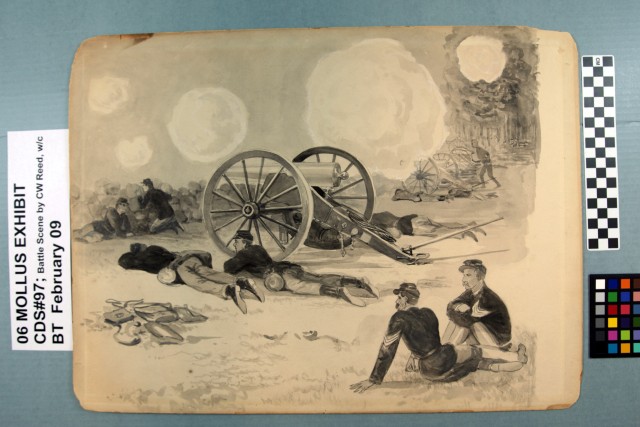During the first week of June 1865, like many of the volunteers who fought for the preservation of the Union, Private Charles Wellington Reed was heading home. Beginning with his enlistment into the 9th Massachusetts Light Battery in 1862, he would be swept by the tides of war from the horrors of Gettysburg to the wilds of the Wilderness, and eventually to Appomattox, Virginia, where he would witness the surrender of Confederate forces to General Ulysses S. Grant. It was on the fields of Abraham TrostleAca,!a,,cs farm in Gettysburg, Pennsylvania, where Reed would save the life of his commanding officer, Captain John Bigelow, earning him the Congressional Medal of Honor in 1895. During those years as chief bugler of his battery and (starting in November of 1864) as an assistant to the topographical engineer under General Gouverneur K. Warren at V Corps headquarters, Reed related his experiences in the war not only in letters home but in sketches and drawings of the people, places, and events he witnessed . It is through these letters and sketches that future generations are granted an extraordinary glimpse into the daily life of this individual soldier.
After the war, Reed served as a lieutenant in the Massachusetts militia. He entered into a liquor distribution business with his father-in-law and, in 1880, purchased a home for himself and his wife, Rebecca Francis Farwell Reed. It was here that Reed began to re-ignite his artistic talents and turned to painting as a means of recounting his days in the Civil War. Many of his sketchbooks, drawings, and paintings were donated to the Library of Congress two years after his death in 1926. However, two of the watercolor paintings produced by Reed are now housed within the collections of the Military History Institute at the Army Heritage & Education Center in Carlisle, Pennsylvania.
In 1974, the Massachusetts Commandery of the Military Order of the Loyal Legion of the United States gave a large portion of its collections of books, manuscripts, artifacts, photographs, paintings, and drawings to MHI. The collection of over 40,000 photos was one of the most comprehensive holdings of surviving Civil War images. Found within this collection are two, 20Aca,!A?x15Aca,!A?, watercolor paintings by Reed, depicting two Civil War scenes. The first portrays a Federal artillery battery in action during a battle. Smoke fills the air over the scene of artillery soldiers sheltered behind a stone fence along a tree line. The second shows a Union General, sword raised, urging his brave infantrymen into battle. A small white clover design found on one of the soldierAca,!a,,cs hats signifies the scene as one from a charge conducted by soldiers belonging to the Second Division of the Second Army Corps. While the papers show signs of age, ReedAca,!a,,cs paintings are in fairly good condition considering that they are at least 130 years old. Preservation will assist in hindering any further damage to the support papers, and proper handling and storage within the museum collections of the Army Heritage & Education Center will ensure Charles Wellington ReedAca,!a,,cs works will continue to benefit future generations of Soldiers and of professional and amateur historians.
ABOUT THIS STORY: Many of the sources presented in this article are among 400,000 books, 1.7 million photos and 12.5 million manuscripts available for study through the U.S. Army Military History Institute (MHI). The artifacts shown are among nearly 50,000 items of the Army Heritage Museum (AHM) collections. MHI and AHM are part of the: Army Heritage and Education Center (AHEC), 950 Soldiers Drive, Carlisle, PA, 17013-5021.
Related Links:
A Working Bibliography of MHI Sources: 9th Massachusetts Light Artillery Battery




Social Sharing